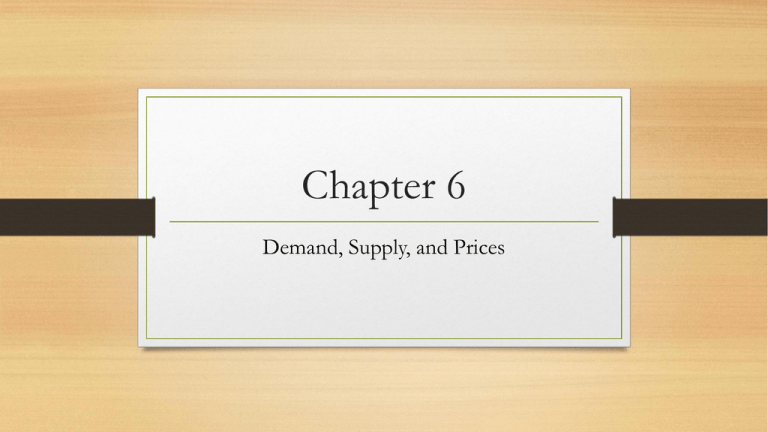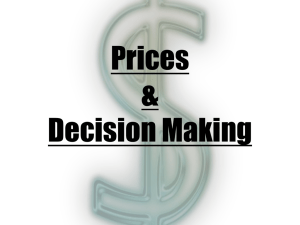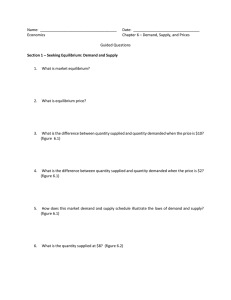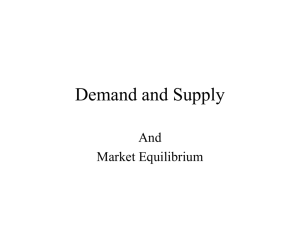Chapter 6
advertisement

Chapter 6 Demand, Supply, and Prices Section 1 • Seeking Equilibrium: Demand and Supply The Interaction of Demand and Supply As buyers and sellers interact the market moves towards a market equilibrium Where the quantity supplied at a certain price matches the quantity demanded at that price This can produce an equilibrium price where the price is equal between the quantity supplied and quantity demanded. Market Demand and Supply Schedule Market Demand and Supply Curve Reaching the Equilibrium Price In order to reach an equilibrium price markets generally go through a surplus (quantity supplied greater than quantity demanded) or a shortage (quantity supplied lesser than the quantity demanded) Through trial and error equilibrium is finally reached Surplus is measured by a horizontal ABOVE the equilibrium. When there is a surplus prices tend to drop until the surplus is sold Reaching the Equilibrium Price A shortage is measured by a horizontal line BELOW the equilibrium price A shortage is when not enough products are produced When a shortage takes place prices generally rise until the quantity supplied matches the quantity demanded Reaching the Equilibrium Price Equilibrium Price in Real Life • Anytime there is an imbalance in quantity demand and quantity supplied you have disequilibrium and the process of finding equilibrium starts over again. Section 2 •Prices as Signals and Incentives How the Price System Works Competitive Pricing occurs when producers sell goods and services at prices that best balance the twin desires of making the highest profit and luring customers away from rival producers How the Price System Works There are 4 characteristics of a price system: 1. It is neutral – prices don’t favor either the producer or consumer 2. It is market driven – market forces, not central planning determine prices 3. It is flexible – When market conditions change prices are able to change quickly 4. It is efficient – Prices will adjust until the maximum number of goods and services are sold. Prices Motivate Producers and Consumers Because of the basic laws of supply and demand Consumers want to buy items at the lowest possible prices and producers want to get the maximum amount of profit possible at the same time they put into play incentives or a way to encourage people to take a certain action. Prices Motivate Producers and Consumers For producers the price system has 2 major advantages: It provides both information and motivation Prices act as signals and incentives for consumers as well. Advertising from producers Encouragement that low prices wont last and they need to buy now or lose the opportunity High prices discourage consumers Price is the most important factor but the other influences from producers on consumers also effects consumers Section 3 • Intervention in the Price System Imposing Price Ceilings Sometimes in order to prevent a price from getting to high people set a price ceiling (limit to how high a price can go) An example : College Football tickets : If you sale them for $30 a ticket for a 50,000 seat stadium and 100,000 people want tickets you could naturally let ticket prices rise until the demand equaled the number of tickets being sold OR you could set a price ceiling and let the demand remain higher than the supply. Setting Price Floors A price floor is opposite of a price ceiling and sets the absolute minimum price an item can be sold at. Minimum wage is an example of a price floor stating the absolute minimum that a business must pay their employees. If a minimum wage is set to high then businesses may feel it is not profitable to hire more workers they will hire less employees. Rationing Resources and Products Rationing is a system in which the government allocates goods by a means other than price to the people. This is generally in a Communist type society where everyone gets the same goods and services so the Government rations (distributes) them out equally to the people When this happens a lot of time people will go to a black market (where goods and services are illegally bought and sold in violation of price controls or rationing)










